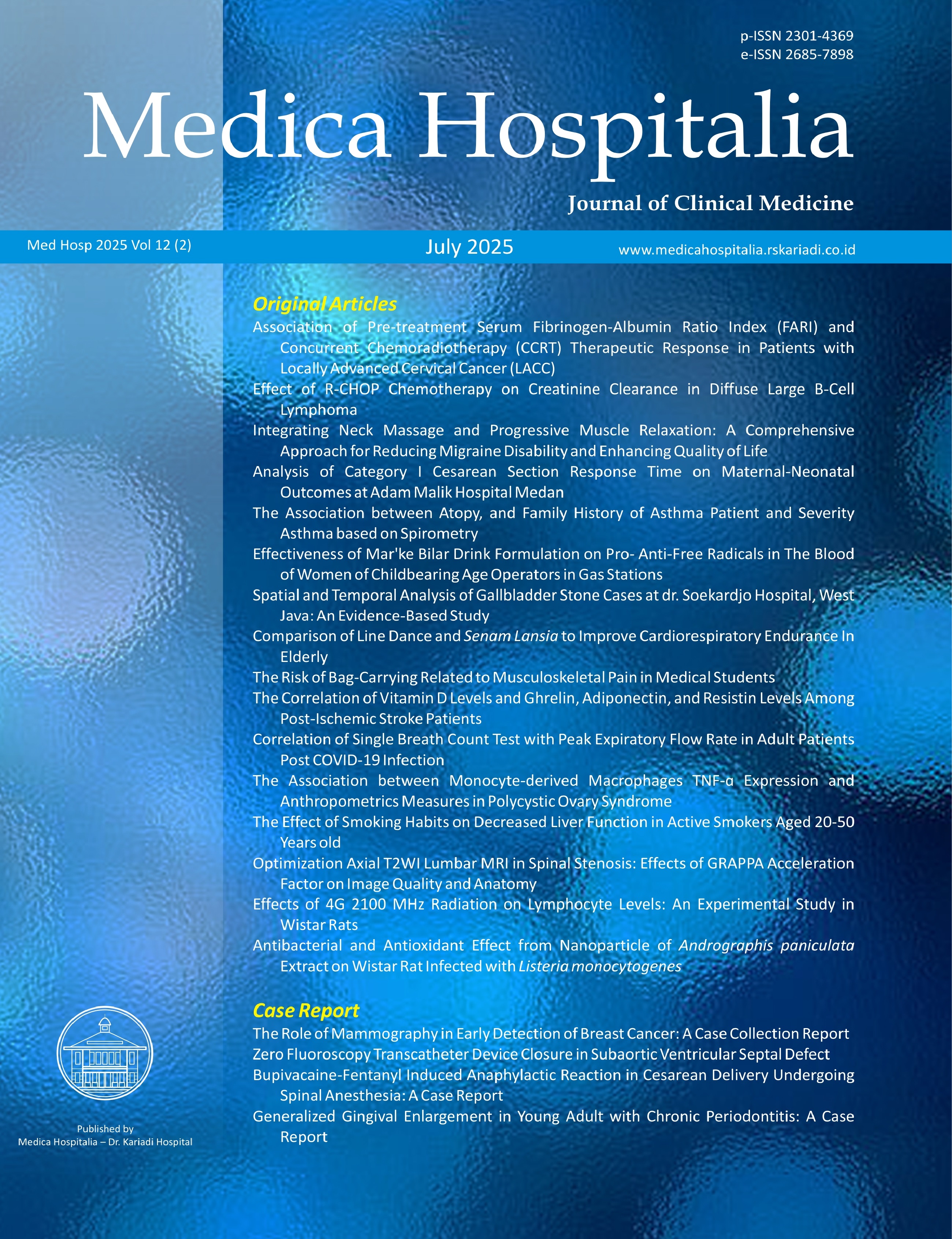Association of Pre-treatment Serum Fibrinogen-Albumin Ratio Index (FARI) and Concurrent Chemoradiotherapy (CCRT) Therapeutic Response in Patients with Locally Advanced Cervical Cancer (LACC)
DOI:
https://doi.org/10.36408/mhjcm.v12i2.1207Keywords:
Fibrinogen-albumin ratio index, concurrent chemoradiotherapy, therapeutic response, cervical cancerAbstract
BACKGROUND: Cervical cancer is currently the second most prevalent women malignancy cases in Indonesia. High prevalence of cases diagnosed as locally advanced cervical cancer / LACC (FIGO Stage IIB-IVA), where concurrent chemoradiotherapy (CCRT) is the main treatment modality. Several therapeutic efficacy predictors in other malignancy cases including the pre-treatment serum fibrinogen-albumin ratio index (FARI) have been associated with therapeutic response to CCRT. However, there were no recent studies in cervical cancer cases.
AIMS: To determine the association of pre-treatment FARI and CCRT therapeutic response in patients with LACC.
METHOD: This is a prospective cohort study in patients with LACC from January – May 2024 whose clinical stage was determined. The pre-treatment FARI was calculated in patients who had met both inclusion and exclusion criteria, and undergone the CCRT regimen. Patients who completed the regimen were evaluated for therapeutic response. Data processing was carried out using SPSS 25 for Windows software.
RESULT: In this study, it was found that the complete response (CR) group with the best outcome had the smallest pre-treatment FARI (9.79 ± 1.71), on the other hand the progressive disease (PD) group had largest pre-treatment FARI (33.72 ± 12.78). In addition, all CCRT therapeutic response groups had significantly different FARI values (P value < 0.05) and the FARI cut point value of 12.44 had a sensitivity of 100% and a specificity of 78.1% for predicting complete response (CR) to CCRT.
CONCLUSION: Low pre-treatment FARI is significantly associated with the likelihood of patients having a complete response (CR), which is the best outcome to CCRT.
Downloads
References
1. Bhatla N, Aoki D, Sharma DN, Sankaranarayanan R. Cancer of the cervix uteri: 2021 update. International Journal of Gynecology & Obstetrics. 2021;155(S1):28–44.
2. Pimple S, Mishra G. Cancer cervix: Epidemiology and disease burden. Cytojournal. 2022;19:21.
3. Indonesia Globocan 2020 [Internet]. International Agency for Research on Cancer, World Health Organization ; [cited 2023 Nov 25]. Available from: https://gco.iarc.fr/today/fact-sheets-populations
4. Singh D, Vignat J, Lorenzoni V, Eslahi M, Ginsburg O, Lauby-Secretan B, et al. Global estimates of incidence and mortality of cervical cancer in 2020: A baseline analysis of the WHO global cervical cancer elimination initiative. The Lancet Global Health. 2023;11(2).
5. Hoffmann B, Schorge J, Bradshaw K, Halvorson L, Schaffer J, Corton M. Williams Gynecology, Fourth Edition. McGraw Hill Professional; 2020.
6. Human papillomavirus and related cancers, fact sheet 2023 [Internet]. International Agency for Reseach on Cancer ; [cited 2023 Nov 26]. Available from: https://hpvcentre.net/statistics/reports/IDN_FS.pdf
7. Monk BJ, Tan DS, Hernández Chagüi JD, Takyar J, Paskow MJ, Nunes AT, et al. Proportions and incidence of locally advanced cervical cancer: A global systematic literature review. International Journal of Gynecologic Cancer. 2022;32(12):1531–9.
8. Cohen PA, Jhingran A, Oaknin A, Denny L. Cervical cancer. The Lancet. 2019;393(10167):169–82.
9. Liu J, Tang G, Zhou Q, Kuang W. Outcomes and prognostic factors in patients with locally advanced cervical cancer treated with concurrent chemoradiotherapy. Radiation Oncology. 2022;17(1).
10. Chen C-C, Wang L, Lin J-C, Jan J-S. The prognostic factors for locally advanced cervical cancer patients treated by intensity-modulated radiation therapy with concurrent chemotherapy. Journal of the Formosan Medical Association. 2015;114(3):231–7.
11. Pal A, Kundu R. Human papillomavirus E6 and E7: The cervical cancer hallmarks and targets for therapy. Frontiers in Microbiology. 2020;10.
12. Zayed S, Nguyen TK, Lin C, Boldt G, Beriwal S, Creutzberg CL, et al. Red blood cell transfusion practices for patients with cervical cancer undergoing radiotherapy. JAMA Network Open. 2021;4(4).
13. Ferro M, Musi G, Serino A, Cozzi G, Mistretta FA, Costa B, et al. Neutrophil, platelets, and Eosinophil to lymphocyte ratios predict Gleason score upgrading in low-risk prostate cancer patients. Urologia Internationalis. 2018;102(1):43–50.
14. Garam N, Maláti É, Sinkovits G, Gombos T, Szederjesi A, Barabás L, et al. Platelet count, ADAMTS13 activity, von Willebrand factor level and survival in patients with colorectal cancer: 5-year follow-up study. Thrombosis and Haemostasis. 2018;118(01):123–31.
15. Feng F, Zheng G, Wang Q, Liu S, Liu Z, Xu G, et al. Low lymphocyte count and high monocyte count predicts poor prognosis of gastric cancer. BMC Gastroenterology. 2018;18(1).
16. Lin Y, Liu Z, Qiu Y, Zhang J, Wu H, Liang R, et al. Clinical significance of plasma D-dimer and fibrinogen in digestive cancer: A systematic review and meta-analysis. European Journal of Surgical Oncology. 2018;44(10):1494–503.
17. He Z-Q, Duan H, Ke C, Zhang X-H, Guo C-C, Al-Nahari F, et al. Evaluation of cumulative prognostic score based on pretreatment plasma fibrinogen and serum albumin levels in patients with newly diagnosed high-grade gliomas. Oncotarget. 2017;8(30):49605–14.
18. Chen P, Wang C, Cheng B, Nesa EU, Liu Y, Jia Y, et al. Plasma fibrinogen and serum albumin levels (FA score) act as a promising prognostic indicator in non-small cell lung cancer. OncoTargets and Therapy. 2017;Volume 10:3107–18.
19. Huang L, Mo Z, Zhang L, Qin S, Qin S, Li S. Diagnostic value of albumin to fibrinogen ratio in cervical cancer. The International Journal of Biological Markers. 2020;35(2):66–73.
20. An Q, Liu W, Yang Y, Yang B. Preoperative fibrinogen-to-albumin ratio, a potential prognostic factor for patients with stage IB-IIA Cervical Cancer. BMC Cancer. 2020;20(1).
21. Sabır YA, Çift T, Karaşin SS. Determining the relationship between serum acute phase reactants and cervical premalignant lesions: A cohort study. Sao Paulo Medical Journal. 2023;141(3).
22. Hwang K-T, Chung JK, Roh EY, Kim J, Oh S, Kim YA, et al. Prognostic influence of preoperative fibrinogen to albumin ratio for breast cancer. Journal of Breast Cancer. 2017;20(3):254.
23. Wang J, Huang D, Wang Y, Yuan Q, Chen X, Cheng Y. Pretreatment plasma fibrinogen and serum albumin levels predict therapeutic efficacy of concurrent radiochemotherapy for esophageal squamous cell cancer. Frontiers in Oncology. 2022;12.
24. Lu S, Liu Z, Wang Y, Meng Y, Peng R, Qu R, et al. A novel prediction model for pathological complete response based on clinical and blood parameters in locally advanced rectal cancer. Frontiers in Oncology. 2022;12.
25. Tang M-J, Ding S-B, Hu W-Y. Fibrinogen and albumin score changes during preoperative treatment can predict prognosis in patients with locally advanced rectal cancer. Gastroenterology Research and Practice. 2019;2019:1–8.
26. Eisenhauer EA, Therasse P, Bogaerts J, Schwartz LH, Sargent D, Ford R, et al. New response evaluation criteria in solid tumours: Revised recist guideline (version 1.1). European Journal of Cancer. 2009;45(2):228–47.
27. Cohen J. Statistical power analysis for the behavioral sciences. Routledge; 2013.
28. Pratiwi SE, Trianto HF, Fatinah NN, Ilmiawan MI, Fitrianingrum I, Lestari D. The Profile of Cervical Cancer Patients at Soedarso Hospital. Indonesian Journal of Cancer. 2022 Apr 1;16(1):33–8.
29. Purnamasari NDA, Tjokroprawiro BA, Utomo B, Nila Kurniasari. Clinical profile of geriatric cervical cancer patients in a tertiary hospital in Surabaya, Indonesia. MOG. 2023 Apr 27;31(1):36–44.
30. Sun C, Wang S, Ye W, Wang R, Tan M, Zhang H, et al. The Prognostic Value of Tumor Size, Volume and Tumor Volume Reduction Rate During Concurrent Chemoradiotherapy in Patients With Cervical Cancer. Front Oncol. 2022 Jul 14;12:934110.
31. Li N, Zhang Y, Qu W, Zhang C, Ding Z, Wang L, et al. Analysis of systemic inflammatory and coagulation biomarkers in advanced cervical cancer: Prognostic and predictive significance. Int J Biol Markers. 2023 Jun;38(2):133–8.
32. Li B, Deng H, Lei B, Chen L, Zhang X, Sha D. The prognostic value of fibrinogen to albumin ratio in malignant tumor patients: A meta-analysis. Front Oncol. 2022 Sep 29;12:985377.
33. Onoprienko A, Hofstetter G, Dorittke T, Bekos C, Grimm C, Polterauer M, et al. The Prognostic Value of the Fibrinogen-Albumin-Ratio Index (FARI) in Patients with Advanced Vulvar Cancer. JPM. 2022 Nov 10;12(11):1882–91.
34. Wang X, Xu J, Zhang H, Qu P. The effect of albumin and hemoglobin levels on the prognosis of early-stage cervical cancer: a prospective, single-center–based cohort study. BMC Women’s Health. 2023 Oct 24;23(1):553–62.
35. Jiang Y, Gu H, Zheng X, Pan B, Liu P, Zheng M. Pretreatment C-Reactive Protein/Albumin Ratio is Associated With Poor Survival in Patients With 2018 FIGO Stage IB-IIA HPV-Positive Cervical Cancer. Pathol Oncol Res. 2021 Dec 21;27:1609946.
36. Yu W, Ye Z, Fang X, Jiang X, Jiang Y. Preoperative albumin-to-fibrinogen ratio predicts chemotherapy resistance and prognosis in patients with advanced epithelial ovarian cancer. J Ovarian Res. 2019 Sep;12(1):88.
37. Chen W, Shan B, Zhou S, Yang H, Ye S. Fibrinogen/albumin ratio as a promising predictor of platinum response and survival in ovarian clear cell carcinoma. BMC Cancer. 2022 Dec;22(1):92–101.
38. Zhang L, Zhang J, Wang Y, Dong Q, Piao H, Wang Q, et al. Potential prognostic factors for predicting the chemotherapeutic outcomes and prognosis of patients with metastatic colorectal cancer. Clinical Laboratory Analysis. 2019 Oct;33(8):1–13.
39. Lu S, Liu Z, Zhou X, Wang B, Li F, Ma Y, et al. preoperative fibrinogen-albumin ratio index (FARI) is a reliable prognosis and chemoradiotherapy sensitivity predictor in locally advanced rectal cancer patients undergoing radical surgery following neoadjuvant chemoradiotherapy. Cancer Management and Research. 2020;Volume 12:8555–68.
40. Li S, Jiang Y, Lin J, Zhang J, Sun F, Gao Q, et al. Albumin‐to‐fibrinogen ratio as a promising biomarker to predict clinical outcome of non‐small cell lung cancer individuals. Cancer Medicine. 2018 Apr;7(4):1221–31.
Additional Files
Published
How to Cite
Issue
Section
Citation Check
License
Copyright (c) 2025 Gezta Nasafir Hermawan, Bismarck Joel Laihad, Joice Margretha Mathilda Sondakh (Author)

This work is licensed under a Creative Commons Attribution-ShareAlike 4.0 International License.
Copyrights Notice
Copyrights:
Researchers publishing manuscrips at Medica Hospitalis: Journal of Clinical Medicine agree with regulations as follow:
Copyrights of each article belong to researchers, and it is likewise the patent rights
Researchers admit that Medica Hospitalia: Journal of Clinical Medicine has the right of first publication
Researchers may submit manuscripts separately, manage non exclusive distribution of published manuscripts into other versions (such as: being sent to researchers’ institutional repository, publication in the books, etc), admitting that manuscripts have been firstly published at Medica Hospitalia: Journal of Clinical Medicine
License:
Medica Hospitalia: Journal of Clinical Medicine is disseminated based on provisions of Creative Common Attribution-Share Alike 4.0 Internasional It allows individuals to duplicate and disseminate manuscripts in any formats, to alter, compose and make derivatives of manuscripts for any purpose. You are not allowed to use manuscripts for commercial purposes. You should properly acknowledge, reference links, and state that alterations have been made. You can do so in proper ways, but it does not hint that the licensors support you or your usage.
























